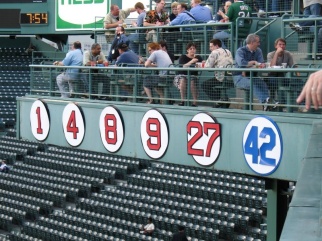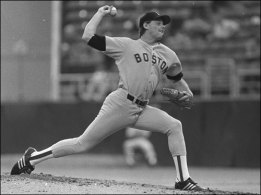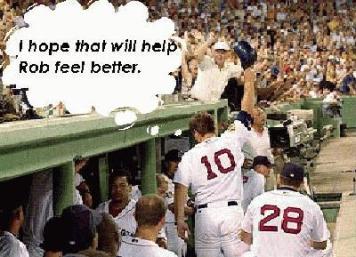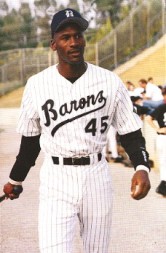 “Tonight, you need to take your son to his summer league baseball tryouts, OK?” my wife said to me on a recent Sunday morning. No problem, I replied. I assumed that every child would be placed on a team appropriate for his level of skill, and that my baseball-loving son would simply be auditioning to show coaches which team he belonged on. What is it that they say about assumptions?
“Tonight, you need to take your son to his summer league baseball tryouts, OK?” my wife said to me on a recent Sunday morning. No problem, I replied. I assumed that every child would be placed on a team appropriate for his level of skill, and that my baseball-loving son would simply be auditioning to show coaches which team he belonged on. What is it that they say about assumptions?
56 kids showed up for the tryout at a field with four diamonds. Each checked in at a table and received two stickers with a number — one for the front of the shirt, one for the back of the shirt. Then, they all found a partner and started warming up. What a sight: 28 pairs of 8 year-olds playing catch, each with visions in their heads of making a summer travel team, hitting .400, and eventually playing for the Boston Red Sox. Even the ones who can’t catch or throw very well.
Parents toting thermoses set up their lawn chairs at one end of the field to watch. I struck up a conversation with a friendly looking dad, and it was then that I learned that only 26 of these children would make a team — that there would be an “American” team and a “National” team (each consisting of 13 players) and that 30 kids would be cut. Those 30 kids would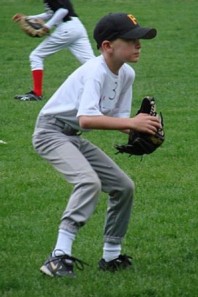 have NO team to play on this summer. (“The spring league is for participation,” the other dad told me. “The summer league is for development and competition.”)
have NO team to play on this summer. (“The spring league is for participation,” the other dad told me. “The summer league is for development and competition.”)
I was stunned. In my own baseball experience, I didn’t face do-or-die tryouts until sophomore year in high school (I still remember Coach Cohen reading my name at the end of that tryout, indicating I had barely made Brookline High’s JV team. In fact, the stick I picked up off the ground and held in my hands as he read my name sits on my dresser, the only good luck charm I’ve ever had.) Thinking from the point of view of an 8 year-old ballplayer, I was stunned at the harshness of it. And I was bewildered by the idea of 30 moms and dads consoling their third graders about not having a team to play on this summer. What would I say to my son if he were cut? Honestly, I couldn’t even begin to imagine that conversation. The kid lives for baseball. It would be devastating. I decided to cross that bridge if I came to it, and hope for the best.
The children were split into four groups of 14, and they cycled through four stations (hitting, ground balls, fly balls, and live infield situations) where they were evaluated by two to three coaches, each scribbling away on his clipboard after every play. Suddenly, it dawned on me that the skills my son had developed during those endless hours of wiffle ball in our backyard, and the thousands of ground balls and fly balls we had practiced in our front yard, and the two seasons of coach-pitch little league were being evaluated right now. It occurred to me that if I’d known the cut-throat nature of our town’s summer league tryouts, I’d have practiced a lot more with my son over the last year. Then it occurred to me that it was probably good that I didn’t know this, since it might have brought out the the “crazy over-coaching dad” that’s probably inside of me somewhere, which definitely would have killed my son’s passion for the game. His wiffle ball experience will have to carry him, I reasoned.
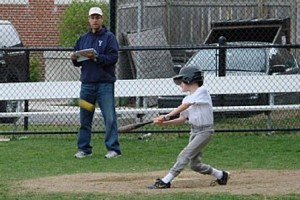 My heart sank every time he swung and missed. I wanted to bellow some encouragement to him, but with all the other parents silently rooting against my son, it didn’t feel right. Then he connected. I was surprised at my pride. Then a line drive, and another one. A couple of foul balls, a miss, then a weak grounder to third. “NEXT!” yelled the evaluator, and he was back in the field. Was that good enough? I asked myself.
My heart sank every time he swung and missed. I wanted to bellow some encouragement to him, but with all the other parents silently rooting against my son, it didn’t feel right. Then he connected. I was surprised at my pride. Then a line drive, and another one. A couple of foul balls, a miss, then a weak grounder to third. “NEXT!” yelled the evaluator, and he was back in the field. Was that good enough? I asked myself.
He looked solid on the grounders – got in front of every ball, kept his butt down, used two hands, made some crisp throws to first base. For a moment, I deluded myself into believing I’d taught him his technique — the truth is, he was simply imitating his favorite player, Nomar Garciaparra.
 At the end of the tryout, the coaches called the kids in and had them get down on one knee at home plate. Then one of the coaches brought out a gigantic trophy and explained to the youngsters that last year’s 8 year-old team from our town had gone undefeated and had won that trophy, and that the tryout group couldn’t touch it until they had won the right to have their own team’s name engraved on it. Nice. 30 of these kids are going to get bad news in a few days, and now that news will be even more painful to receive. I assure you, none of those 56 kids was in a state of mind to be inspired by the trophy – they just wanted to earn the chance to wear a town uniform!
At the end of the tryout, the coaches called the kids in and had them get down on one knee at home plate. Then one of the coaches brought out a gigantic trophy and explained to the youngsters that last year’s 8 year-old team from our town had gone undefeated and had won that trophy, and that the tryout group couldn’t touch it until they had won the right to have their own team’s name engraved on it. Nice. 30 of these kids are going to get bad news in a few days, and now that news will be even more painful to receive. I assure you, none of those 56 kids was in a state of mind to be inspired by the trophy – they just wanted to earn the chance to wear a town uniform!
Part II of the tryout continued one week later. The kids were obviously grouped by ability this time, and I was relieved to see that my son was in a group of somewhat capable players. I just wanted him to make a team — any team! I hadn’t begun to compose my “Michael Jordan didn’t make his high school JV team” speech, and I really didn’t want to. 30 of us parents were going to have to come up with something to ease their pain, though. I dreaded that, for all of us.
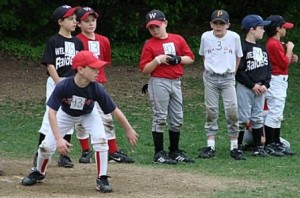 In the final twenty minutes, the coaches had the players line up at home plate and they timed them running from home to first, then again from home to second. As the kids crossed the base, the timer yelled out the results for all to hear, and another guy with a clipboard wrote down the times. I felt like I was at the NFL pre-draft combine. Then, the five fastest kids raced, then they narrowed it to two, and those two raced…. and we have a WINNER! And everyone cheered for the fastest boy. (The point of this, other than pure enjoyment for the adults running the tryout, completely eludes me.)
In the final twenty minutes, the coaches had the players line up at home plate and they timed them running from home to first, then again from home to second. As the kids crossed the base, the timer yelled out the results for all to hear, and another guy with a clipboard wrote down the times. I felt like I was at the NFL pre-draft combine. Then, the five fastest kids raced, then they narrowed it to two, and those two raced…. and we have a WINNER! And everyone cheered for the fastest boy. (The point of this, other than pure enjoyment for the adults running the tryout, completely eludes me.)
On the way home, my son spoke with total self-confidence. He was sure he had made one of the teams. I suspected all 56 of the young men felt the same way. “If you do make a team, do you care which team you’re on?” I asked. Nah, he said, I just want to play. I was about 43 times more nervous for him than he was for himself. So, this is what it’s like being the parent of an aspiring athlete, I thought. (Butterflies, and a total lack of control over the outcome.)
 Then came the wait. 3 days, 4 days, 5 days, and no word from the league. “Did you get an email?” was the first thing my wife and I said to each other when we talked on the phone from work, or when we arrived home in the evening. “Nope, nothing.” Finally, an email came late one night. Based on the recommendation of our evaluators, we are pleased to offer your child a position on our Summer Eight Year Old National Team.
Then came the wait. 3 days, 4 days, 5 days, and no word from the league. “Did you get an email?” was the first thing my wife and I said to each other when we talked on the phone from work, or when we arrived home in the evening. “Nope, nothing.” Finally, an email came late one night. Based on the recommendation of our evaluators, we are pleased to offer your child a position on our Summer Eight Year Old National Team.
I woke up my wife to tell her. We both felt the relief sweep over us, like we had just dodged a cannonball. And our son? When we told him the next morning, he was actually a little bit disappointed. Turns out he had his heart set on the American team, which he perceived to be the more prestigious of the two. Did I mention he’s got a lot of self- confidence?
I couldn’t help but wonder about the other 30 kids who’d been cut, all of whom wanted to play baseball this summer. And what about their parents? At the same moment my wife and I were feeling a rush of relief, they were all preparing their consolation speeches. What could they say? “Michael Jordan was cut from his high school JV basketball team” is a good start, but then what? Perhaps towns should give all parents a Handbook on Talking With Your Child About Tryouts when they arrive on that first day. I know I could have used something like this had my son not been so fortunate….
POSTSCRIPT: My son read this article and said to me, “Daddy, half of the article is about what you would say to me if I didn’t make the team. But Daddy, there was no chance I wouldn’t make one of the teams.” Son, did you think about the other 30 kids who wanted to play summer baseball too, but got cut? “Daddy, they didn’t believe as much as I did.”








































